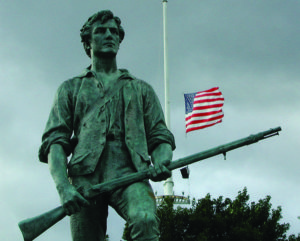If the Second Amendment Was Meant for Genocide, Is It Sacred?

Roxanne Dunbar-Ortiz’s new book, Loaded: A Disarming History of the Second Amendment, could be criticized for how little it seems to discuss the Second Amendment and how much it focuses on topics familiar from the author’s past writing. But the topics are radically unfamiliar to most Americans and extremely relevant to understanding what the Second Amendment was and is.
I’ve argued, as have others, that the Second Amendment was written with militias in mind, that it should be seen as state resistance to federal militarism, and that what was called a gun or “arms” at the time of the Bill of Rights has very little in common with the guns people defend with the Second Amendment today. I still think there is truth in all of that, and certainly in the implied point that nobody in their right mind would create an individual right to own guns if they were writing a constitution today. (And no other country ever has.)
But Dunbar-Ortiz presses home the point that the Bill of Rights was a bill of individual rights, and that it provided the individual right to keep and bear arms in plain English, and that doing so (keeping and bearing arms) was very common at the time. In fact, some colonies had required white men to keep and bear arms and to never travel without them. Dunbar-Ortiz further provides meaning to the Second Amendment by re-inserting into our sanitized history some basic facts about what sort of society the colonies and the new nation that followed were.
If the Second Amendment had been written in a society that mostly used guns for hunting, one would assume it had to do with hunting. If it had been written in a society that mostly used guns as art objects in museums, one would assume that’s what it was about. If it had been written in a society where guns were commonly used to resist government oppression, well that would then be its meaning. But none of those scenarios is connected to reality. The fact is that the Second Amendment was written in a society where guns were used—individually, in small groups, and in regulated militias—primarily and routinely to commit genocide and to maintain slavery.
In 1763, Britain defeated France. King George III quickly decreed that any British settlements west of the Allegheny-Appalachian mountains must be abandoned. But settlers continued to pour over the mountains, steal Native Americans’ land, and form militias. Needing to pay for more soldiers to stop the settlers, Britain created the Stamp Act in 1765. Revolution started brewing. The Second Amendment, Dunbar-Ortiz believes, adds up to the right to violently appropriate Native land.
Settlers had organized their own ethnic-cleansing militias since 1676 in Massachusetts. But militias were also used as slave patrols, and it was some of the wealthiest owners of plantations using enslaved labor who most resented the British ban on moving west to steal more farmland. Slave-patrol militias moved west with settlers, being used, for example, to enforce slavery in Texas while it was still part of Mexico and after Mexico had banned slavery in 1836. Following the US Civil War, better armed and trained militias took the form of organizations such as the Ku Klux Klan, as well as evolving into modern police forces.
Dunbar-Ortiz claims that gun culture runs so deep in the United States, that public opinion is the problem, not NRA lobbying. I think this is important but only partly true, as it ignores the fact that opinion polls favor restrictions on guns that Congress will not enact, as well as the fact that the strongest supporters of the gun dealers in Congress are also the best funded by said gun dealers. Still, Dunbar-Ortiz reports that nearly 75 percent of the US populace believes that guns are a source of political rights and power. Certainly many believe this across the political spectrum. And it’s patent nonsense. It’s belief accommodating itself to a so-called sacred amendment that should be no more sacred than any other antiquated tool of genocide.
